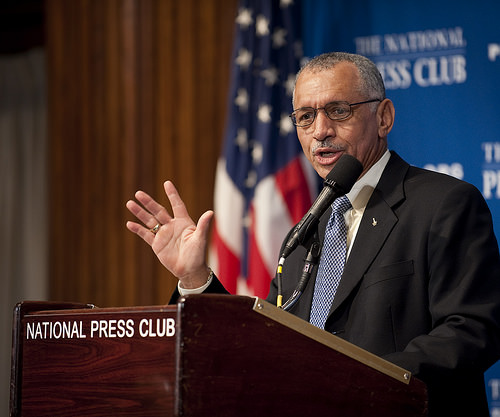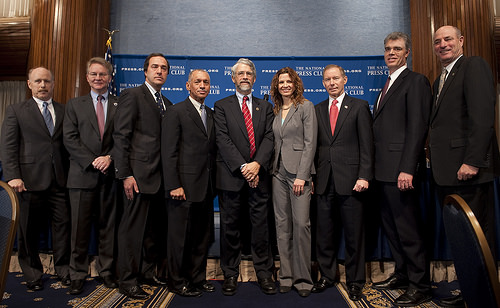[/caption]
NASA Administrator Charlie Bolden introduced today five commercial space companies that NASA will use to support transport of crew to and from low Earth orbit as part of the Commercial Crew Development program. The firms were selected in an open competition for $50 million in funds from the American Recovery and Reinvestment Act of 2009. During the event, Bolden countered the criticism of NASA’s new plan proposed by President Obama. “I respectfully disagree if you think we are abandoning human spaceflight. I think we’ll get there quicker. This is a fundamental re-baselining and a new ways of doing business to develop a program that is truly sustainable for the long term,” Bolden said. “This is a roadmap to even more historic achievements… We are not abandoning human space flight by any stretch of the imagination. We are on a new course, but human space flight is in our DNA.”
Several of the companies already do business with NASA, such as Boeing and United Launch Alliance – a coalition between Lockheed and Boeing.
Boeing will receive $18 million to work on a seven-person capsule that may launch on a medium-class expendable launch vehicle. Bruster Shaw from Boeing said “We’ve been in this game a long time and we have a vested interest in the International Space Station. We want to see ISS live up to its potential by having a robust logistics for the delivery of cargo and crew.”
Paragon Space Development Corporation will receive $1.4 million for life support systems, primarily an “air revitalization” system. President and founder Jane Poynter said, “We have developed and tested an array of technologies to use in a whole array of settings: on the ISS, the Moon, Mars. Air revitalization is the first of its kind, and will be a turnkey system to be used on any spacecraft on an array missions. We are deeply committed to the development of space for human exploration.”

Sierra Nevada Corporation will receive $20 million for the development of their “Dream Chaser,” a seven-person crew vehicle based on the Hl-20 runway landing, heavy lifting body concept (looks similar to the canceled Crew Return Vehicle for the ISS). Mark Sirangelo, Chairmen and Vice President of Sierra Nevada said, “Space is hard, it takes a lot of cooperation and teamwork. We have come through an unfunded space agreement with NASA, and have advanced our program to be very successful. We are looking forward to moving to the next level.”
The United Launch Alliance will receive $6.7 million for an emergency detection system for that will allow crewed capsules to launch on the Atlas and Delta rockets. Mike Gass, ULA President and CEO said “ULA has been supporting the nation with over 50 years of experience. Atlas and Delta will be used to support commercial crew in the future, and it’s all about crew safety, and we’ll provide a synergistic system to provide safe support.”
Blue Origin will receive $3.7 million for a new type of crew escape system. Robert Millman from Blue origin said, “We are dedicated to creating technology for enduring human presence in space. We are developing a “pusher” escape system, with an escape motor at back of capsule to avoid a jettison event.” They are also working on a composite pressure vessel to improve the durability for a conventional crew cabin.

Also in attendance at the press conference were the companies that already have contracts with NASA through the COTS program, Space Exploration Technologies (SpaceX)and Orbital Sciences Corp. David Thompson, CEO of Orbital applauded the new direction for NASA. “At their first turn at bat the Obama administration hit it out of the park. This new approach represents a dramatic change, and is consistent with what we’ve seen in this country and around the world, where there is an increased reliance on an ever-more reliable private sector. It seems this is the right time and direction for the agency to take in this new era, and I’m confident the private sector is up for new challenges”
Former astronaut Ken Bowersox with SpaceX said, “One of the most exciting thing about the budget is that it acknowledges one of the biggest barriers to exploring space: how to pay for it. It is going to be great to watch what happens when we blend the skills available in government with flexibility of the private sector.”
Top photo notation: From left, Ken Bowersox, VP Astronaut Safety, SpaceX, David Thompson, CEO, Orbital Science Corporation, Mark Sirangelo, VP and Chair, SNC Space Systems Board, Sierra Nevada Corp., NASA Administrator Charles Bolden, Assistant to the President for Science and Technology and Director of the White House Office of Science and Technology Policy Dr. John P. Holdren, Jane Poynter, President and Chair, Paragon Space Development Corp., Brewster Shaw, VP and General Manager, NASA Systems, Boeing, Robert Millman of Blue Origin, and, Mike Gass, President and Chief Executive, United Space Alliance.


“It is going to be great to watch what happens when we blend the skills available in government with flexibility of the private sector.”
This could make the AOL-TimeWarner merger look smooth by comparison.
LC
This is truely awesome news, and I suspect precisely what needed to happen.
In other news, HHS rolled out a photo-op with health insurance executives to promote Medicare’s bold new “flexible aging” initiative.
“I respectfully disagree if you think we are abandoning human spaceflight. I think we’ll get there quicker.”
Get where quicker?
And why are we building an entirely new capsule (how will it be different) and why are we investing in the dream chaser?
Is this the speech?
Absolute hysterical report. Days ago we were taking billions on making systems, now the private sector is now taking in a couple of millions on development.
Sugar coated propaganda to swallow those recent bitter pills, eh?
Well, a bit scattered effort. But this is follow-ons from earlier efforts. Hopefully the advertised NASA plan (‘not for weeks, but not a year away’) will provide focus as, err, plans are supposed to.
Without a strategic plan, it’s healthy to polish off earlier efforts. $50 MUSD to the private sector is change, but the ~ 2GUSD needed to stop the previous admin pipe dream development programs without the congress critters getting restless isn’t.
As always, blame it on the politicians. 😀
LOL!
In other news we learned that we are all aging at the same rate in this here inertial frame according to some fellow named Einstein. Curiously, he has himself stopped aging.
These directions are fine for the (human exploration aspect) however I’m interested in discourse about alternative propulsion systems and the so lauded (refueling) stations needed for the timely exploration of our solar system.
Not to mention funding for the development of probes to the solar system.
There is a white elephant in the room. How do we get Hydrogen and Oxygen to use as fuel into space?. Some Significant funding should be awarded to Plasma Engines development or derivatives of.
Unless we aim to harvest fuel beyond earths orbit we will still have to lift these (raw materials) into space from earth. Some fresh thinking is needed here. The parameters however are different, you are lifting hydrogen and oxygen into earth orbit.
And big amounts of it. This does not need to ride into orbit like a firecracker, but can instead float up increasing its velocity as it ascends. Indeed the density of our atmosphere could assist its upward motion.
Hydrogen itself will lift a third of the way to LEO. If you have enough of it you can use some of it to lift you the rest of the way and utilize plasma or ion engines once in LEO to maneuver and maintain orbit. However in doing so you will probably use up all the Oxygen in the process. So additional LOX might have to ride the traditional firecracker up. Unless Hydrogen itself is sufficient for Ion or plasma engines.
Balloon launches were tried in the 60’s, but there was a fundamental difference. They were trying to get the rocket into space. Not the fuel.
Damian
OH its good to see Jane Poynter in that group. Good luck to Paragon Space.
Perhaps with more funding some dialogue on Biomes in space can happen as well. 🙂
Sorry for the double post.
Damian
That looks like Jaws from Drax Industries second from right he’ll help with the hope and change that koolaid drinkers can belive in….. now do they happy about how the world views American now??? I can care if they like us or now at lease before we had a plan to keep a launch ability. Kenya doesnt need space they need trains.
Koolaid drinkers? No cool man, not cool.
Boeing will receive 18 million greens to work on a seven man capsule? Is this a joke?
If things were that cheap we’d be in Andromeda by now
tripleclean – what the hell? Your post made next to no sense. Just sayin’.
5000 till 10.000 euro seems to be a fair price for a trip to a moon….really im not joking, everybody nowadays can fly almost anywhere with a plane for not too much money.
The airline industry was also quite for the elite only a couple of decades ago…..we need it now because our civilization is ready for it.
frankly it would be the final frontier of the human freedom and evolution of the personal transportation vehicle ground>air>space
Hon. Salacious B. Crumb got it right. Seriously, a few million dollars does not even train up a single astronaut, let alone develop new untested launch systems. There is no way any corporation is able to develop and manage a program as complex and expensive as the shuttle program, particularly when the payoff at the end it dubious. The idea a few million dollars will facilitate the development of a better launch vehicle is laughable. When I was in 4-5th grade I and a couple of friends tried to build a spacerocket. This is almost the same thing.
This is a way of dropping the whole ball. Back in the 70s the government set up a similar program for jet fighters. I forget which company it was, but they developed a light fighter called the F-19, which the government then rejected and the company took a huge financial loss. At least in that case a couple of planes were actually built, but with space systems suspect nothing will actually be developed, and the program will whimper out in the night.
LC